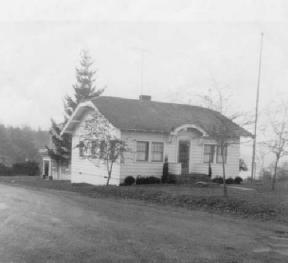If the strains of long ago piano music played by small fingers seem to linger between the book stacks, around the computers, within the CDs and in the large light reading room of the Langley Library, they are only harking back to the earliest days of that venerable institution.
Less than 10 years after the building was completed in January, 1923, a $30 piano was purchased, and the Langley Library added one more aspect to its many and varied uses.
As Langley marks the 80th annivesary of its library with a celebration and a mayor’s proclamation, longtime residents remember the early days when the present building was only a small house-like structure — as well as a recreation center, music hall, meeting place and any other gathering space for the small town on South Whidbey.
According to a letter published in 1980 in The Whidbey Island Record from Laila McRae, a librarian for 13 years, the idea for a library began with the Ladies Civic Improvement Club, which formed in 1916 with the slogan, “A better, more beautiful Langley.” But its main purpose was to start a library. Its first books were donated and stored in a shed at Joseph Primavera’s store.
By 1921 the group had incorporated as the Langley Civic Club to raise money for a building.
The prime mover of the project, McRae wrote, was Miss Helen Coe, who was the first female mayor of Langley and became the first librarian. She donated the land on which the library still stands, as well as $500 to start a building.
“Construction began, with most of the materials and labor donated by community members, and with money raised by all kinds of entertainments and projects,” McRae wrote.
“The building was designed for immediate use as a recreational hall in the large front room and a library in the small room (in the back),” she wrote. The only heat was a fireplace, with donated wood stored under the seats around the hall. Electric lights were installed in 1924.
For the next 20 years or more, the library was in almost constant use, with the rentals going to building maintenance and its growing collection of books.
According to McRae, the building was used for meetings of the Townsend Club, the Co-op Egg Association, Republican and Democratic clubs, the Pension Union and Telephone Company, among others. The Town Council met in the library in 1929 for $3 a month.
In 1943, the Civic Club deeded the land and buildings to the Town of Langley, which then began to contribute to the library fund.
In 1961, the Town Council signed a contract with the newly formed Sno-Isle Regional Library. Shelves were built to hold the volumes of new books and open hours increased three-fold.
In 1980, with the population of South Whidbey growing, the little library got a small addition.
“It offered people a place to sit,” said Nancy Lindholdt, who was librarian for 20 years, from 1977-98. “It was almost all volunteer work. We were very proud to have more space, and everybody loved that little building. But as soon as we moved in we knew we were at least five years behind already.”
The last expansion project at the Langley Library was in 1994.
“At one time we thought of having just one central library on South Whidbey,” Lindholdt said. “But people like their small libraries.”
Lindholdt’s staff consisted of two people, one page who came in three hours a day, and an assistant who worked once a week.
Today, branch manager Vicky Welfare presides over a total of eight staff members in a library open six days a week. She enumerated its services:
“The library provivdes books, magazines, cassettes, CDs, videos and DVDs for checkout; children’s and adult programming; free Internet access and word processing capabilities; and access to the collections of 20 other libraries in the Sno-Isle system.”
Some groups still meet in the library: the Friends of the Library and the Langley Book Discussion Group among them.
But it is as a library that the great strides have been made.
“The circulation total for 2002 was 116,728 items checked out,” Welfare said. “In 1923, 42 books was a good day.”



